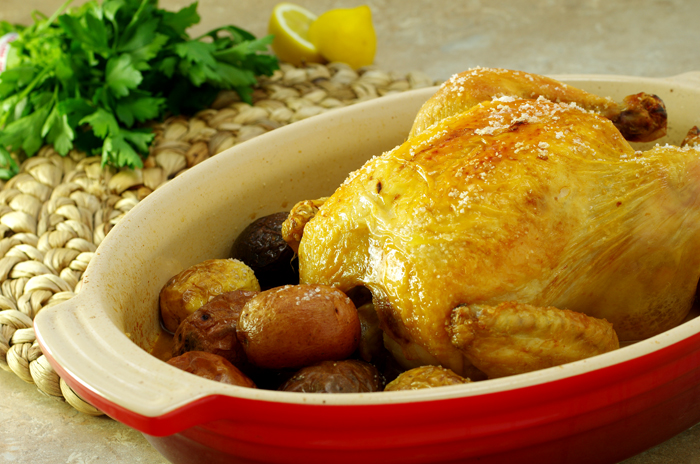Perfect Roasted Chicken
Serves 4
Click here for a printable version of the recipe.
There are three finesse points to a perfect roasted chicken. Though infinite variables make one roasted chicken different from another (the quality of the chicken, the seasonings used, how long you cook the bird), three main goals are essential if you want to wind up with a perfect roasted chicken. They concern seasoning, oven temperature, and – the most talked-about issue but rarely addressed practically—the maintenance of a juicy breast and fully cooked thighs.
Seasoning in this case is salt. A chicken should be liberally salted. It should have a visible coating of salt, not just a fey sprinkle. As Thomas Keller put it to me, “I like it to rain down on the chicken.” An aggressive use of salt not only seasons the exterior so the chicken tastes delicious, it also helps dehydrate the skin so that you wind up with a crisp brown skin and not a pale soggy one.
Chickens should be roasted in a very hot oven, as hot as your stove and kitchen can take. A hot oven – ideally 450°F/230°C/gas 8 but at least 425°F/220°C/gas 7 – accomplishes two important feats: it browns the skin, and it cooks the leg and thigh fast, giving the breast less opportunity to dry out.
The most common reason people end up with a dry and flavorless breast it that they fail to address what is happening in the cavity of the bird. If the ends of the legs are not tied together in front of the cavity or if the cavity is empty, hot air swirls around the cavity of the bird, cooking the breast from the inside out. To prevent this, you must truss the chicken, which I think is part of the pleasure of roasting a chicken, but most home cooks don’t want to bother with it. If you count yourself among the latter, simply put something into the cavity, preferably something tasty – lemon, onion, garlic, herbs. I repeat: if you don’t want to truss the chicken, stick a lemon in it.
Of course, you don’t want to under- or over-cook the bird. My experience of roasting a chicken most weeks of the year for the past twenty years is that 1 hour at 450°F/230°C/gas 8 is perfectly sufficient for a 4-pound/1.8 kilogram bird (50 minutes for a bird under that). But as a rule of thumb, you should use the cavity juices to judge doneness. After 45 minutes, if you tilt the bird so that the juices spill cracklingly into the rendered fat, you will notice that they are red. When you tilt the chicken and the juices that stream out are clear, it’s safe to take the bird out of the oven.
Finally, a chicken ought to rest a good 15 minutes before you cut into it. Don’t worry about the chicken getting cold. It won’t. It’s a big, solid bird that retains heat well (touch it after 10 minutes and see for yourself).
One 3- to 4-pound/1.4- to 1.8 kilogram chicken
1 lemon and/or 1 medium onion, quartered (optional)
Kosher salt
About 1 hour before cooking the chicken, remove it from the refrigerator, and rinse it. If you intend to make a pan sauce, cut off the wing tips and add them, along with the neck if you have it, to the pan in which you will roast the bird. Truss the chicken or stuff it with the lemon or onion, or both. Salt it and set it on a plate lined with paper towels/absorbent paper.
Preheat the over to 450°F/230°C/gas 8 or to 425°F/220°C/gas 7 if you’re concerned about smoke. Set the oven on convection if that’s an option. Put the chicken in an oven-proof frying pan and slide it into the oven.
After 1 hour, check the color of the juices. If they run red, return the chicken to the oven and check it again in 5 minutes. Remove the chicken from the oven and let rest for 15 minutes before carving it.
Carve the chicken and serve. |


